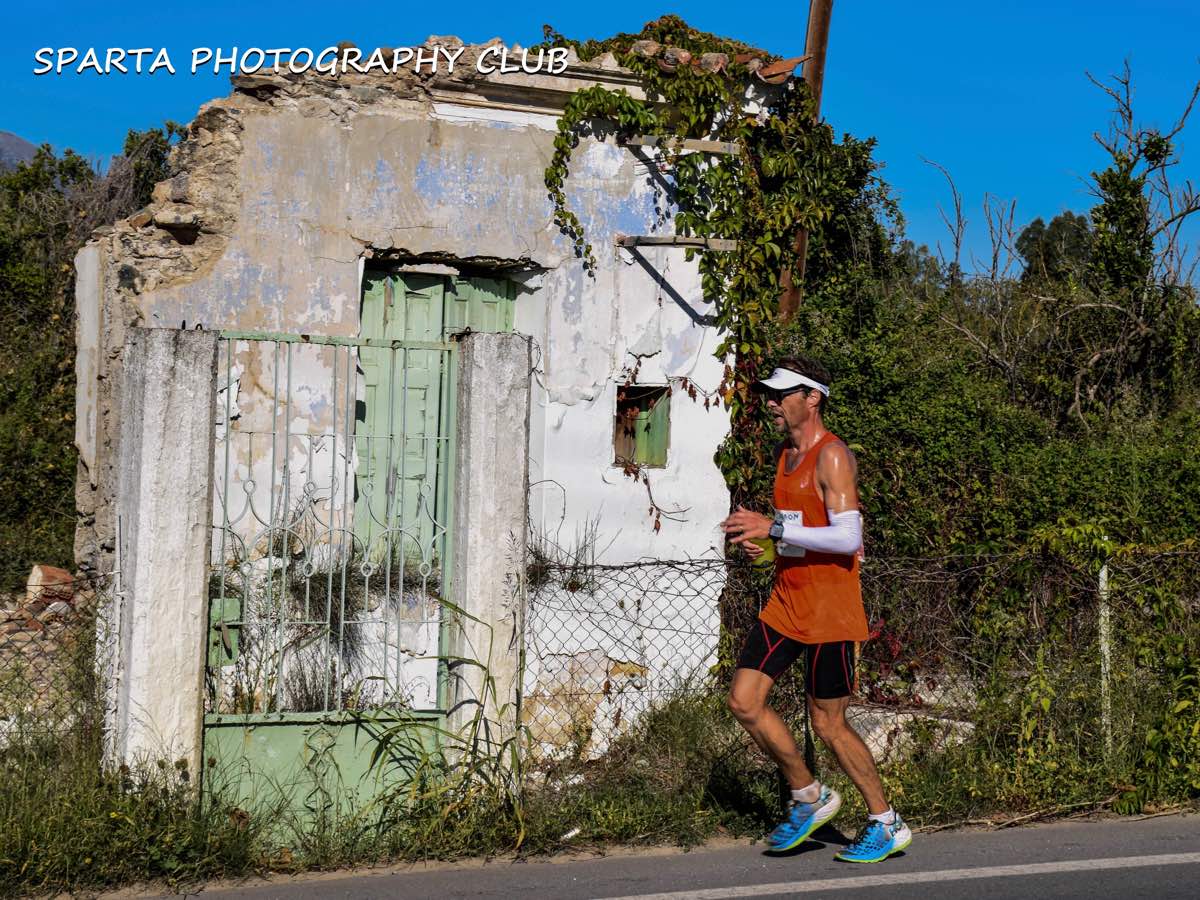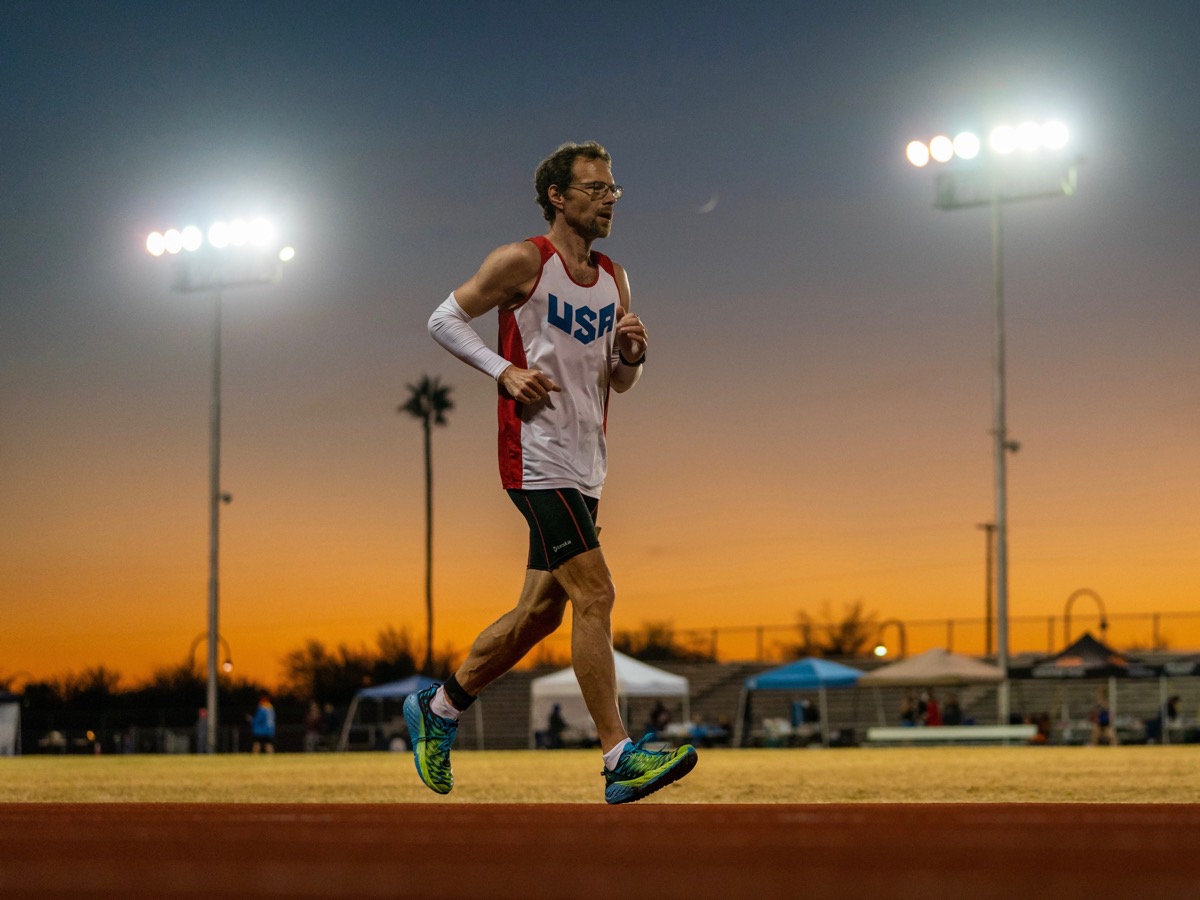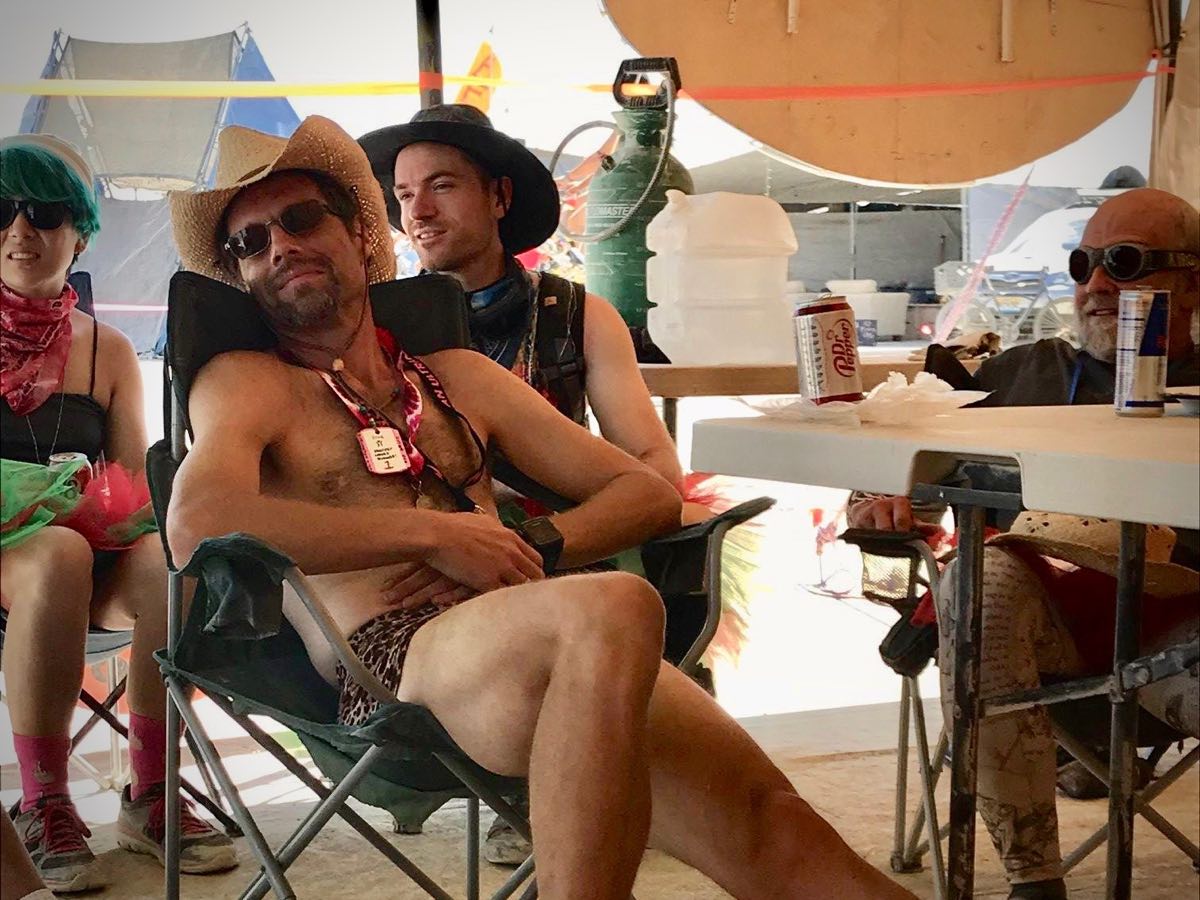‘Age-Old Runners’ is an article series where we explore runners’ performance potential after the age of 45 by interviewing excellent middle-aged runners. Is there still potential to improve? What roles do motivation, mindset, and specific training and recovery techniques play in allowing runners in their mid-40s to mid-60s to continue to excel? To learn more about this series’ goals, check out its introductory article.
Bob Hearn is 54 years old. He started running when he was 38 and didn’t run his first ultramarathon until age 42. In that time, Bob has run more than 70 ultras including the Badwater 135 Mile and three Spartathlons (153 miles). He specializes in 24-hour, 48-hour, and longer events. Bob set the American 50-54 age-group record for 24 hours on the road in 2017 when he was 51 years old by running 152 miles at the Run4Water 24-Hour Race. A year later, he set the American 50-54 age-group record for 24 hours on the track with 154 miles at Desert Solstice. He holds the American 50-54 age-group 200k records for road and track. And he set the American 50-54 age-group record for 48 hours on the road at the Snowdrop Ultra with 232 miles in 2018. Last year, he ran 530 miles at Six Days in the Dome, which puts him on the top-10 overall list of American six-day performances.
The following is a transcript of a phone interview with Bob. It has been edited for brevity and clarity.
Why did you start running?
My wife has always been a runner. I met her in college, and I abortively tried to start running to impress her. But it was always too boring to run for the sake of just running or fitness. We moved to Vancouver, British Columbia and I got talked into this team entry to a 10k in 2004. I’d never run that far, so I dug up a training plan. And I suddenly realized that a training plan and goal made all the difference in the world. I was hooked, and it took off from there.
Did you do any sports during high school?
Marching band is as close as I got to sports.
[Author’s Note: Bob is young in running years. He’s only got 16 years on his legs.]
How did your running progress from that first 10k when you were 38 years old to multi-day ultras now?
For several years, it was all about the marathons … around the Marathon Maniacs. At the time, that was a small thing. I was Marathon Maniac #543, I think. [Author’s Note: There are now more than 15,000 Marathon Maniacs.] You’d see these yellow singlets, and they were very rare. And it was like, How do I get one of those Marathon Maniacs singlets? You had to run two marathons within two weeks or something. And I was like, Wow! That seems really hard, but maybe I can do that once. But then you do it once, and you’re in the club, and you see the list, and you see that if you want to get more stars…. [Author’s Note: Marathon Maniacs is a running club whose members achieve different star levels by running marathons in different time frames. For example, the gold level is running four marathons in 37 days.]
Once I had done two marathons in one weekend, a friend of mine said, “If you can do that, you can do a 50 miler. Come run this 50 miler with me.” That turned out to be the White River 50 Mile, which totally kicked my ass and scared me away from ultras for a while. But I gradually realized, you know, this is fun. You get to run on the trails. I got my heart set on the Western States 100. I did my first 50 miler in 2008, and then my first 100 miler in 2011 at the Javelina Jundred.
What drew you to the longer distances?
I managed to break 3:00 in the marathon. I’ve been under 3:00 five times, but my PR is 2:58. I was never going to get substantially better than that. If I had devoted my life to it, maybe I could have run a 2:50. But that’s no great shakes for a guy. I remember thinking, I’m never going to be a world-class marathoner. I’ll be better at the longer stuff…. As I realized I was better at ultras, the marathons became training runs.
I have to say, I was never really a good trail runner. That’s why it was kind of a shock when I moved to this longer, flatter stuff and realized I was so much better at it.
Why do you race?
The most proximal reason is the goal of setting age-group records. I would love to set an overall American record at something. It seems like a stretch, but I think I have a shot at the six-day or possibly the 48-hour record. My biggest goal for the last five years has been to make the U.S. 24-Hour Team. I’ve narrowly missed it twice. Things like that are the proximal goals.
And then the larger goals: I’ve recognized how healthy running is for me even though I break myself now and then. On balance, I think it’s extremely healthy physically, mentally, and emotionally. I’ll live a longer and happier life.
But all that is not enough to get me out the door to train. If I haven’t set up my training schedule for the week as part of a race plan, I don’t have the energy to get out the door even though I love running. I’m too lazy a person. So I have to have something, a more proximal goal like, I have to run 80 miles this week because I have to be ready to run this race so I can set this record.
Has why you race changed over the past 16 years?
I never would have thought about setting records before! But it’s always been about setting PRs.
What bothers you about aging as a runner?
I started running at age 38, and I’m 54 now, and every year I’ve managed to PR at some distance. I’ve got to be very close to the age where that’s not going to continue any more. That will be demoralizing.
You know, it takes so much commitment and mental focus to put in the training that I need to run at the level that I want. If I don’t have as big a carrot in front of me, it will be a lot harder. It’s a little scary to me.
You worry that the age-group records won’t be as motivating or as satisfying as PRs?
Yes.
On who inspires him.
I’m able to look at people like Don Winkley and Gene Dykes. Don just set an age-group world record. He’s over 80. Gene is setting world records over age 70. And it’s great that those marks are there. You can set a goal of, I’m going to be 60. I’m not going to run a PR or anything, but I can go for an over-60 age-group record. Don Winkley is my role model for where I want to be in 20 or 30 years. We’ll see.
How do you see your potential as a runner at age 54?
Right now, I’m still improving. There’s a balance because I know my body is aging, but at the same time I’m learning. And so far, the balance, the net, is that I’m improving. I can tell myself that. I feel like I’m getting younger as I get fitter, and smarter, and race better. At some point, time will catch up with me, and then it’s going to be in my face that I’m aging, and that I can’t do what I used to do.
When I ran the Spartathlon four years ago, I met Connie Gardner. We were scheming about how to get me on the US 24-Hour Team. [Author’s Note: The men’s minimum standard for the U.S. 24-Hour Team is 145 miles (233k), but because there only six members on the team, runners have to go quite a bit further than the minimum. In 2019, men needed to run more than 155 miles (249k) to make the team.] Connie told me, “You have a year and a half to run 150 miles.” After the race, she said, “No! I thought again. The next 24-hour race you do, run 160 miles. That’s what you need to do.” I’d just run my first 24-hour race, which was 139 miles, and I’m like, “What? You want me to run 160?” She said, “Yeah, because you’re 50 years old, and whatever big number you’re going to do at 24 hours, you’re going to do it now. You’re not going to do it in five years. So go all out.” You know, there’s some logic to that. Now it’s four years later, and I’m still running PRs. I’m keeping my fingers crossed.
How much do you think you can improve at a 48-hour race?
Well, I ran 232 miles a couple of years ago, and that was good for an age-group American record. The overall American record is 262 miles, which I was shooting for at this last race. Realistically, that was a stretch. I should be able to run in the 240- to 250-mile range. When I ran 232, I didn’t know what I was doing, and I think I can improve a lot over that.
Can you still improve your 24-hour mileage?
It’s hard to say. I ran 154 miles at Desert Solstice a year ago, and I thought at the time, That’s basically my ceiling. I’m not going to be able to do a mile or two better than that. But I’ve kind of changed. I used to have this idea that I don’t need any more aerobic capacity than what it takes to run an easy nine-minute mile. But I think I’ve changed my mind.
On pacing at timed events.
I’ve always had this thought that these very long races are ultimately limited by cumulative muscle damage. It’s easy to run nine-minute miles, but after 24 hours, it’s not easy any more because you’ve accumulated massive muscle damage. I started to make some toy numerical models hoping to confirm my belief that even pacing is best because if you start faster, obviously, you’ll do more muscle damage early that’ll hurt you later. [Author’s Note: Bob has a PhD in Artificial Intelligence and Computer Science and knows what’s what about computer modeling.] What I found was exactly the opposite. This toy model I started with, which is probably not remotely realistic, suggests, with my parameters, if I run even paces in a 24-hour race, I can run 154 miles. But if I actually start much faster and slow gradually throughout the race, then I can run 162 miles. I don’t believe that, but it’s very eye opening. It gives me some encouragement that there’s room to play around with my pacing plan, and there’s some intentional upside there at least. [Author’s Note: A common thread in these interviews is how powerfully a belief in the possibility of development, in potential, is to continued superior performance.]
I still think there are a lot of arguments that running closer to even paces is better because it’s not just cumulative muscle damage. Your weakest link will be much more likely to fail the faster you start. If you’ve got any sort of injury issue going in, it’ll be exacerbated by starting faster. I think even pacing is still sort of the safest way. So choosing your pacing plan is a complicated game of weighing risk versus reward.
Do you think you have a greater capacity to persevere at age 54 than you did when you were younger?
Not really. What I have is more experience and knowledge. I can look back. If I’m halfway through a 24-hour race, or even a six-day race, and I think, I don’t want to be here. There’s no way I can hold this pace. Why don’t I quit? You know, the thoughts that we all have in a long race. I have more data now that I can look back on and say, No, I’m not a quitter. I know that all I have to do is run this next lap. That makes it easier. The more experience I have in not quitting, the easier it is to hang on in a race.
For these fixed-time things that are on short loops, it’s a very different mental game than a point-to-point race. I think that having a more mindful, meditative approach helps a lot. So I’ve been doing mindfulness meditation. You could call that a change in life perspective that has helped too. I try to meditate daily. Mostly it’s focusing on breath; sometimes I will use guided meditations. When I am doing long runs at the track, I will intersperse periods of mindful running where I focus completely on my form and how my body feels.
What has gotten harder about racing as you age?
Sleep deprivation is a huge issue for me now. I mean, I’m a programmer, and in college, I would pull all-nighters all the time. Sometimes two and three nights in a row. And now, if I do a race that goes into the second evening, that is so mentally hard. Forty-eight hours may be the most brutal format. Because at 24 hours, you don’t sleep. At six days, everybody sleeps. But at 48 hours, if you want to set records, you don’t have much time. You can’t have a real sleep. Some people can do that. That is getting harder as I get older.
What’s changed about your training since you started racing?
More miles. Flatter miles. Slower miles. Now that I focus on these really long flat things, I do a lot of miles on the track. I’ll go a couple of times a week and do long runs at the track.
Looking back, would you have changed anything about the volume you ran, or the manner in which you trained?
I had this idea that as I moved up to the longer stuff that aerobic capacity is not very relevant. If I can run a nine-minute mile all day long, then I don’t really care what my VO2max is. But I’ve sort of realized more recently that I think that thinking is wrong.
I think I need to being doing more tempo work. We’ll see how that plays out going forward. The problem is, if I try to do any faster running, then injuries limit me more. There’s always something I’m running up against, whether it’s a hamstring, pain behind the knee, or hip flexors. And those generally limit my speed.
Do you get injured more now?
My biggest problems are my tendons. Maybe I have an overall genetic issue with tendons or something. I’m not sure if the injuries are getting worse because I’m getting older, or because I’m doing more abuse. It’s hard to tell.
Is recovery tougher than it was when you started?
Not really. Maybe injuries heal slower. I’ve always taken a bunch of time off after a race. If I do a 24-hour race and I go all out, I won’t run for two weeks, maybe three. I’ll try to get out and walk, to be active and get the blood flowing. I don’t see any sense in pushing it. I take my time with recovery.
Your overall volume continues to increase?
Yeah, last year was about 3,500 miles, which is not huge, but it was a little bigger than in the past. The graph shows a gradual uptrend. But, like I said, those miles are flatter and slower than the miles I was doing 10 years ago.
Tell me about your long runs when you’re building up to races.
Typically, for the two months before a big race, I’ll do 20-ish miles at the track once a week and something like 15 miles at the track in the middle of the week. Sometimes I’ll find an ultra to use as a training run. Often, maybe two weeks before a 24-hour race, I’ll do 20 miles at the track in the morning and another 20 in the evening. [Author’s Note: !!!] Or sometimes I’ll do a longer 40 or 50 miler at the track. That’s not something I’ll do every week.
Tell me about your current diet.
I went ketogenic after I met Steve Phinney when I ran Western States in 2014, and he gave me a copy of his book. I was skeptical, but I gave it a try. Shortly after I went keto, I did my first 24-hour race, and I suddenly realized, Oh my god! I’m in this totally different world. I don’t know how much of that is that maybe I’m becoming better adapted at 24 hours and longer stuff, or how much the keto actually helped me.
With keto, I cut my calorie intake while racing. Now I take in 100 to 150 calories an hour [of various sugars] instead of 300 calories an hour…. Also, I did a 50 miler after I’d been on the keto diet for a month or two, and at the end of it, my legs felt like they’d run 50 miles, but my brain was fresh. It was totally eye opening. I think it does help with mental fatigue.
My sense is that keto works very well for somebody like me who wants to run this long flat stuff where I never have to run faster than a nine-minute mile, and I don’t have any hills where I need extra energy. I’m able to satisfy almost all of my energy needs with a higher fat-burn rate. I cheat after a race. I’ll eat carbohydrates for a couple of weeks, and then I’ll get back on it…. But when I’m on it, it’s typically 30 grams of carbs a day.
How do you fuel yourself during a race? Has that changed?
I used Maurten for a while, and now I use my own mix that is very similar to Maurten. I tweak the proportions. For a while, fueled with only Coke, and I realized that once I’d switched to Maurten, I wasn’t getting the steady trickle of caffeine, so I added in enough caffeine to match what I was getting from Coke.
I try to change it up during the race. I’ll alternate that with Coke, or Sword, or something. That’s working well. I haven’t had any real issues the last few races.
How do you use caffeine during races?
The harder question is: During a multi-day race, how to plan the No-Doz and Red Bulls? At the six-day race that I ran two years ago in Hungary, when I tried taking No-Doz the first night, the crash was bad. I think my inclination now for multi-day races is to hold off on the real caffeine hits until very late in the race because you’re just going to pay for it afterward. But I’m still experimenting and learning.
What about strength training? How does that fit into your training program?
It’s very important. I wish I had done more earlier. I should probably be doing more now. I do about a half hour a day of strength training and core stuff. What’s on the menu changes based on my most recent visit to my physical therapist. The older I get, the more critical it’s going to get. This year especially, I’m refocusing on strength. Last year, I had four goal races and all of them were affected by injury. It was a frustrating year.
On being injured.
Almost from the beginning, I’ve had this awareness that injuries are part of the game. As soon as I upped my miles above 50 miles a week when I started running, I started getting injuries. And I was like, Damn! You’ve got to be kidding. This is the way the game is played?
I have a weird injury right now that only manifests itself when I’ve been running for at least 100 miles, a pain behind the knee. Last summer they diagnosed it on site as a likely medial gastrocnemius-insertion tear, but maybe it’s just tendonitis. Maybe it’s a Baker’s cyst. Maybe it’s insufficient mobility and stretching in my hamstrings. It’s hard to know. But it doesn’t manifest unless I’m in the middle of a multi-day race, which really sucks. I’m looking forward to my next six-day race in May, and how do I know that I won’t have this shut me down halfway through it?
What mistakes do you see new runners making?
Wanting to do too much too soon. It never fails that I go to a 24-hour race, and they go out on world-record pace. Nine times out of 10 that’s not going to end well. Mostly, I’m known for even pacing, which is supposed to be hard for most people. It’s not rocket science! Anyone can pace even. Just start slow enough. The hard part is picking the pace, and for many, for some reason, sticking to that pace. I don’t see why that has to be hard. If you put so much effort into training, then why throw it all away on race day by not running according to your plan?
On the desire to continue to be part of our community.
The great thing about the ultra world is how social it is. The social aspect is huge, like at Marathon Maniacs. The friends that I’ve made at these races are lifetime friends. Once you’re hooked into that community, that, in a lot of ways, is reason to keep going back. It’s why I keep going back to Spartathlon every year. I love the race, but it’s also a chance to see friends that I’m only going to see once a year. Even if I’m not running as fast, I hope that would still be a motivator.
Training specifics:
- Weekly running volume: About 70 miles per week, peaking at 110 miles
- Strength training: Thirty minutes daily focusing on core and problem areas
- Off-season: No
- Sleep: Six to seven hours/night
- Race nutrition: Homemade mix similar to Maurten
- Recovery: Two to three weeks completely off after 24-hour and longer events
Three factors Bob attributes his running performance to:
- Analytical approach to planning and pacing as well as discipline when pacing
- Stubbornness/mental toughness
- Diet
Call for Comments (from Meghan)
- What stories can you share about sharing the road and track with Bob Hearn over the years?
- What have you learned from his successes?



